Πεύκα στην Κέρκυρα
 Work Artirst Modal
Work Artirst Modal
Πεύκα στην Κέρκυρα
Παρθένης Κωνσταντίνος (1878/1879 Αλεξάνδρεια - 1967 Αθήνα)
Πήρε πιθανότατα τα πρώτα μαθήματα ζωγραφικής στην Αίγυπτο την περίοδο 1894-1895, από τον Γερμανό καλλιτέχνη Karl Wilhelm Diefenbach και το 1895/1896 πήγε στη Βιέννη, όπου ολοκλήρωσε τις σπουδές του στη Βασιλική Ακαδημία Καλών Τεχνών (1897-1903) και στο Ωδείο.
Το 1903 ήρθε για πρώτη φορά στην Ελλάδα και την ίδια χρονιά έλαβε μέρος στη Διεθνή Έκθεση των Αθηνών, στην οποία τιμήθηκε με αργυρό μετάλλιο. Παραμένοντας πέντε χρόνια στην Ελλάδα, ταξίδεψε σε διάφορα μέρη ζωγραφίζοντας και αγιογραφώντας εκκλησίες. Από το 1909 ως το 1911/1914 έζησε στο Παρίσι, όπου έλαβε μέρος σε διάφορα σαλόνια, μεταξύ των οποίων το Φθινοπωρινό Σαλόνι του 1910, όπου το έργο του "Πλαγιά" τιμήθηκε με βραβείο. Επιστρέφοντας στην Ελλάδα εγκαταστάθηκε για ένα διάστημα στην Κέρκυρα, πήρε την ελληνική υπηκοότητα και έγινε μέλος της λογοτεχνικής και καλλιτεχνικής ομάδας "Συντροφιά των Εννιά". Το 1917 ήρθε οριστικά στην Αθήνα και, μαζί με άλλους καλλιτέχνες, ίδρυσε την "Ομάδα Τέχνη". Το 1929, με προεδρικό διάταγμα του Αλέξανδρου Παπαναστασίου, του οποίου υπήρξε στενός φίλος, διορίστηκε καθηγητής στη Σχολή Καλών Τεχνών, αφού είχε προηγηθεί μια αποτυχημένη προσπάθεια εκλογής το 1923. Στη Σχολή δίδαξε ως το 1947, οπότε και παραιτήθηκε. Η ζωγραφική περιλαμβάνει θρησκευτικά θέματα, τοπία, μυθολογικές και αλληγορικές σκηνές, προσωπογραφίες και νεκρές φύσεις, αντλώντας τις εμπνεύσεις του από την αρχαία και τη βυζαντινή τέχνη αλλά και από τα νεότερα ρεύματα - τον ιμπρεσιονισμό και τον μεταϊμπρεσιονισμό, το συμβολισμό και την Art Nouveau - ανοίγοντας το δρόμο για την ανανέωση της ελληνικής τέχνης.
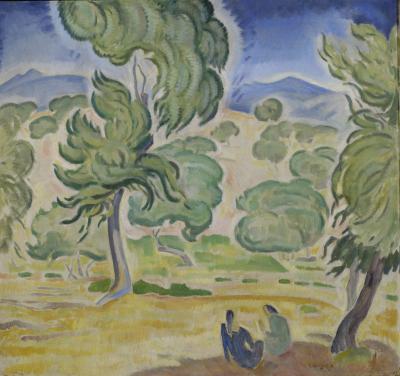
Στη μόνιμη έκθεση του Παραρτήματος της Κέρκυρας εκτίθενται έντεκα έργα του Παρθένη, από όλες σχεδόν τις περιόδους της διαδρομής του. Ωστόσο, από τα πιο εμβληματικά εκτιθέμενα έργα του είναι δύο τοπία της Κέρκυρας, που χρονολογούνται μεταξύ του 1909 και του 1911, όταν ο ζωγράφος ζει στο νησί.
Με τον τίτλο Πεύκα στην Κέρκυρα ο Παρθένης αποτυπώνει ένα τοπίο του νησιού, μια καθημερινή σκηνή μέσα στους ελαιώνες και την πυκνή βλάστηση, τόσο χαρακτηριστική για το κερκυραϊκό τοπίο. Η ανθρώπινη παρουσία σε αρμονική και γι’ αυτό ευφρόσυνη όσμωση με τον φυσικό κόσμο, γίνεται για πολλούς από τους ζωγράφους στις αρχές του εικοστού αιώνα, θέμα προσφιλές, συχνό, που αποκτά συμβολική σημασία καταγράφοντας ταυτόχρονα την καθημερινότητα.
Τα Πεύκα στην Κέρκυρα σηματοδοτούν μια σημαντική στροφή για τη ζωγραφική του Παρθένη, καθώς το σχέδιο γίνεται πιο γωνιώδες, οι ζωγραφικές, φλογόσχημες και καμπυλόγραμμες φόρμες με τον γεωμετρικό χαρακτήρα έχουν αυτόνομη αξία, το χρώμα εναποτίθεται με φειδώ. Την εικόνα μοιάζει να διαπερνά η πνοή του ανέμου.


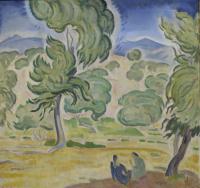
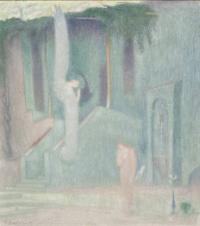
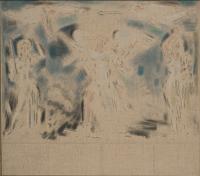
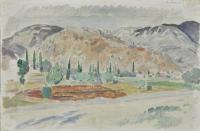
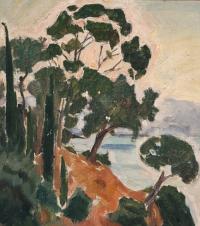

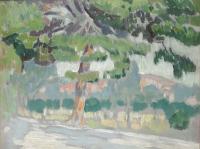
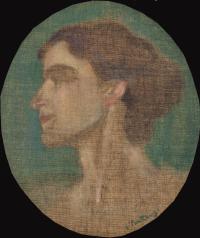

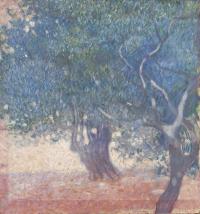
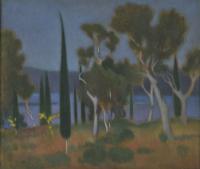
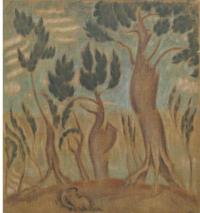

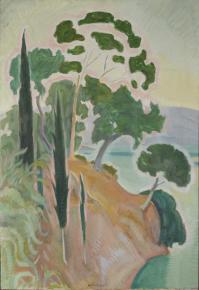
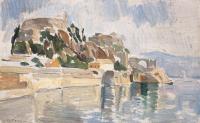
 Π.Ε.Π. ΙΟΝΙΩΝ ΝΗΣΩΝ
Π.Ε.Π. ΙΟΝΙΩΝ ΝΗΣΩΝ

